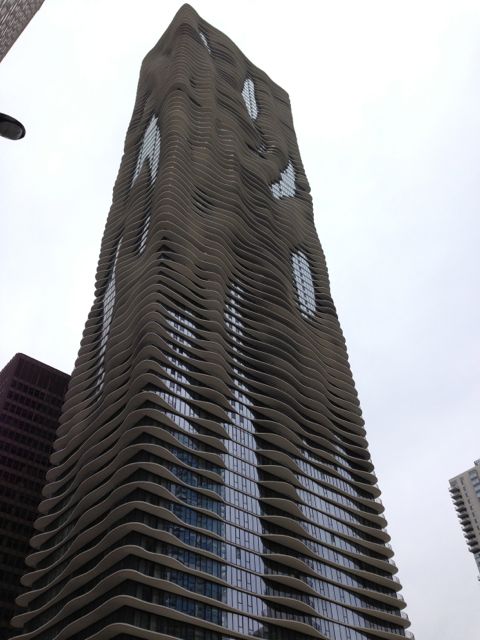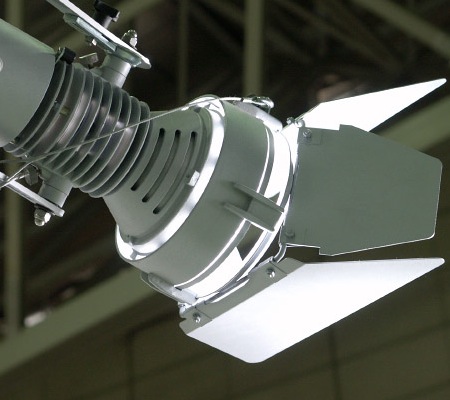So Close Yet So Far – The Aqua Tower and Passive House

This weekend I got a chance to see Aqua, that oozing projection of glass and thermal bridges in downtown Chicago. I’ve written about it before because it’s such an energy efficiency monstrosity, so of course I had to get some photos of it while I was there.
This weekend I got a chance to see Aqua, that oozing projection of glass and thermal bridges in downtown Chicago. I’ve written about it before because it’s such an energy efficiency monstrosity, so of course I had to get some photos of it while I was there.
As with all too many large buildings, Aqua has concrete slabs protruding through the building enclosure and cantilevered out over space. The continuous concrete and steel projections act as thermal bridges. In other words, they’re excellent at moving heat from inside to outside (and vice versa, depending on where the heat is). Move a lot of air over those fins, and they’re even better at removing heat, and Aqua sits in the heart of the Windy City, half a mile or so from Lake Michigan.
Of course, engineers know all about cooling fins. They’re used in lights (photo below), engines, and air conditioners. Apparently, architects don’t believe the hype.

The reason I was in Chicago was to attend the board retreat for the Passive House Institute US (PHIUS) this past weekend. The passive house program, in case you’re not familiar with it, is downright obsessive with its focus on rooting out all thermal bridges. So, although the PHIUS headquarters sit only a few blocks from Aqua, they’re light years apart on the building science spectrum.
Related Articles
Why Do Architects Focus on Art More than Building Science?
Bats Can’t Live Under a Thermal Bridge
Passive House — The Only Place Where Real Innovation Is Happening?
Photo of light by refeia from flickr.com, used under a Creative Commons license.
NOTE: Comments are moderated. Your comment will not appear below until approved.
This Post Has 7 Comments
Comments are closed.

Maybe code should limit
Maybe code should limit equipment size per sf.
Build whatever you want, but it might not be occupiable when it gets super hot or cold…
Allison, I couldn’t think of
Allison, I couldn’t think of a better example of how not to build a high rise these days. Maybe if there were more glass…
Great to see you at the ACI Home Performance Conference last week.
You were in Chicago and you
You were in Chicago and you didn’t stop in the studio? 🙂
Ted K.: Or
Ted K.: Or energy allowed per square foot?
Jim G.: I agree. And great to see you in Detroit, too!
Mike: Yeah, I don’t believe that number either.
Ron: Yes, sorry. Once again, it was a quick in-and-out trip, and I was busy all weekend with the PHIUS board retreat. Plus, I’d just been to Detroit and Santa Fe, NM in the previous 6 days. I’ll catch you on one of my trips, though.
Bill S.: Well, those models are fairly useless then, it seems to me.
Mike: Yep.
So are there any numbers for
So are there any numbers for the building? It’d be much more interesting to see some benchmarks than just suppositions about efficiency. I’m sure you guys are probably right, and man, it’s ugly as sin – but still – I’d love to see some actual numbers for energy use.
Gang will be speaking at the
Gang will be speaking at the AIA convention in Chicago late June; perhaps someone can ask her for data on the building…
I would guess the story is fairly complicated; it’s a mixed-use building, the fins serve as shading, commercial buildings tend to need cooling most of the year (very low balance point) … etc., etc. It would be extremely hard to just guess at whether on balance it’s performing well or not (relative to all-glass; pretty sure it’s not great compared to small window / wall ratio options). The proof is in the pudding.
I performed a home inspection
I performed a home inspection for clients who purchased a large condominium on one of the upper floors of Aqua a few months ago. They called me back a week or two after the inspection in great distress and told me that they were relegated to sleeping in their closet due to the incredible noise that their partition walls were making as they rubbed against the curtain walls. Energy efficiency is not the only shortcoming at this place.